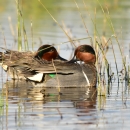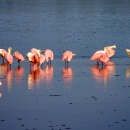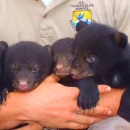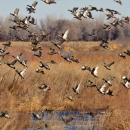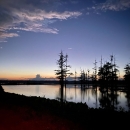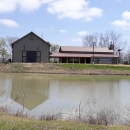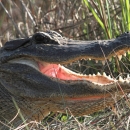Visit Us
Points of Interest
Covering over 40,000 acres in Yazoo and Humphreys Counties, Panther Swamp National Wildlife Refuge is the second largest Refuge in the state of Mississippi. Its expansive bottomland hardwood forests, cypress-tupelo sloughs, and meandering bayous represent some of the best remaining examples of the historically predominant habitat types that once characterized the entire Mississippi floodplain. With its close proximity to the state capitol, Jackson, the Refuge provides a variety of recreational opportunities. These include hunting, fishing, birding, wildlife observation, photography, and boating; public boat ramps are located on Lake George and Deep Bayou. Including the levees along the Whittington Channel, approximately 30 miles of gravel roads are open on the Refuge for most of the year. Additionally, some portions of the Refuge can be accessed from Highway 149W, and Satartia Road. Other areas are accessible by foot or small boat.
Much of the habitat is subject to flooding on an annual basis. The Refuge has a number of bayous that slowly drain flood waters, leaving shallow swamps and oxbow lakes which support stands of tupelo gum, cypress, buttonbush, and other species tolerant to extremely wet habitats. The upland areas or ridges often crest at no more than one foot above swamp areas, and contain Nuttall, willow and water oaks and other species while overcup oak, bitter pecan and ash dominate the transition zone from swamp to upland. Additional habitat types consist of reforested and agricultural areas. Crops left in the field are used to support large concentrations of wintering waterfowl. The Refuge supports healthy populations of resident wildlife and neotropical migrants. Hunting seasons are established for waterfowl and all native game species, which include white-tailed deer, fox and grey squirrels, swamp and cottontail rabbits, raccoon, opossum, and wild turkey. The endangered Louisiana Black Bear is occasionally observed on the Refuge. Most days you can find several alligators sunning along the water’s edge.
In the office lobby are native animal exhibits such as the American Alligator, a black bear, wild turkey, fish, waterfowl, birds and even a raccoon stealing eggs from a wood duck nest. There is also an interactive kiosk which provides neat facts along with photos about the Refuge.
Know Before You Go
Opportunities such as hunting, fishing, wildlife observation, photography, environmental education and interpretation are abundant at Panther Swamp. The climate is mild with the coldest months experiencing low temperatures near 30 degrees F. Summer temperatures frequently reach 100 degrees F. Humidity is highest in August and September reaching an average close to 90%. The highest rainfall comes during the spring months, but December and January are wet too. January is generally the coldest month, while July is the hottest. Winters are mild, with temperatures seldom remaining below freezing for more than 24 hours. The average yearly rainfall is 52.48 inches, with March being the wettest month (averaging 5.62 inches) and August being the driest (2.37 inches). Insect repellent is highly recommended as mosquitoes and red bugs are plentiful.
Activities
National Wildlife Refuges are places where wildlife comes first. Although people are welcome, activities are regulated and monitored to ensure that impacts are minimal to the animals and plants that call the Refuge “home”.
There is no admission fee to visit Panther Swamp NWR; however, everyone sixteen years of age and older, hunting or fishing must have an Annual Public Use Permit in addition to state licenses. Please refer to current Refuge regulations and map for additional information. A Current Public Use Permit is required for access if you are participating in consumptive use such as but not limited to, hunting and angling. Click here to purchase or obtain your permit. For help with log-in or creating your account for purchasing or obtaining an annual public use permit please watch the video instructions.
Each activity listed below is permitted on Panther Swamp NWR and most can occur at any time of the year.
All other public activities on TR Complex are prohibited during firearm deer hunts and Limited Draw Hunts.
Trails
Refuge trails and kiosks provide family-friendly wildlife viewing areas. The Refuge has few hills, so all trails have very little elevation-gain, offering easy walks without losing any of the nature-experience opportunities. Need help navigating? Obtain a current Public Use Regulations Brochure from any of the kiosks or stop by the office to ask questions.
Panther Swamp National Wildlife Refuge does not have any designated walking trails, however, visitors may utilize established ATV trails or other areas at their own risk except in closed areas or during a draw hunt. Refer to the current Public Use Regulations for more information.
Other Facilities in the Complex
Panther Swamp National Wildlife Refuge is one of nine refuges that make up the Theodore Roosevelt National Wildlife Refuge Complex and it serves as the Headquarters for the Complex. Each refuge in the Complex plays vital role to conserving our nation's resources. A National Wildlife Refuge Complex is an administrative grouping of two or more Refuges, wildlife management areas or other Refuge conservation areas that are primarily managed from a central office location. Refuges are grouped into a complex structure structure
Something temporarily or permanently constructed, built, or placed; and constructed of natural or manufactured parts including, but not limited to, a building, shed, cabin, porch, bridge, walkway, stair steps, sign, landing, platform, dock, rack, fence, telecommunication device, antennae, fish cleaning table, satellite dish/mount, or well head.
Learn more about structure because they occur in a similar ecological region, such as a watershed or specific habitat type, and have a related purpose and management needs. Typically, a Project Leader oversees the general management of all Refuges within the complex and Refuge Managers are responsible for operations at specific Refuges. Supporting staff, composed of administrative, law enforcement, Refuge manager, biological, fire, visitor services, and maintenance professionals, are centrally located and support all Refuges within the complex.
Checkout the list below of the other Refuges within the Complex, and visit each one for new and different experiences!
Rules and Policies
Panther Swamp welcomes visitors year-round! All lands managed under TR Complex, including Refuge roads, parking areas and boat ramps are closed 1 1/2 hours after sunset until 4 am. Please refer to current Refuge regulations and map for additional information. A Current Public Use Permit is required for access if you are participating in consumptive use such as but not limited to, hunting and angling. Click here to purchase or obtain your permit. For help with log-in or creating your account for purchasing or obtaining an annual public use permit please watch the video instructions.
Locations
From Jackson, MS
I-20 and I-55 exchange, travel northwest on I-20W toward Exit 43A. Slight right onto US-49N (signs for I-220 / N Jackson / Yazoo City) continue onto I-220 N. Take Exit 5B to merge onto US-49N / Delta Dr / Medger Evers Blvd toward Flora / Yazoo City. Continue to follow US-49N. From Flora Travel 22 miles on US-49N, turn left onto On MS-149 N / MS-16 W / Broadway St, continue to follow MS-149 N / MS-16W for 12 miles. Office is on the left.
From Belzoni, MS
Hwy 12 and US-49W S exchange, travel south on US-49W S 5 miles, turn right onto MS-149 S, travel 15 miles (From MS-14 E and MS-149 intersection, travel 5 miles). Office is on the right.

